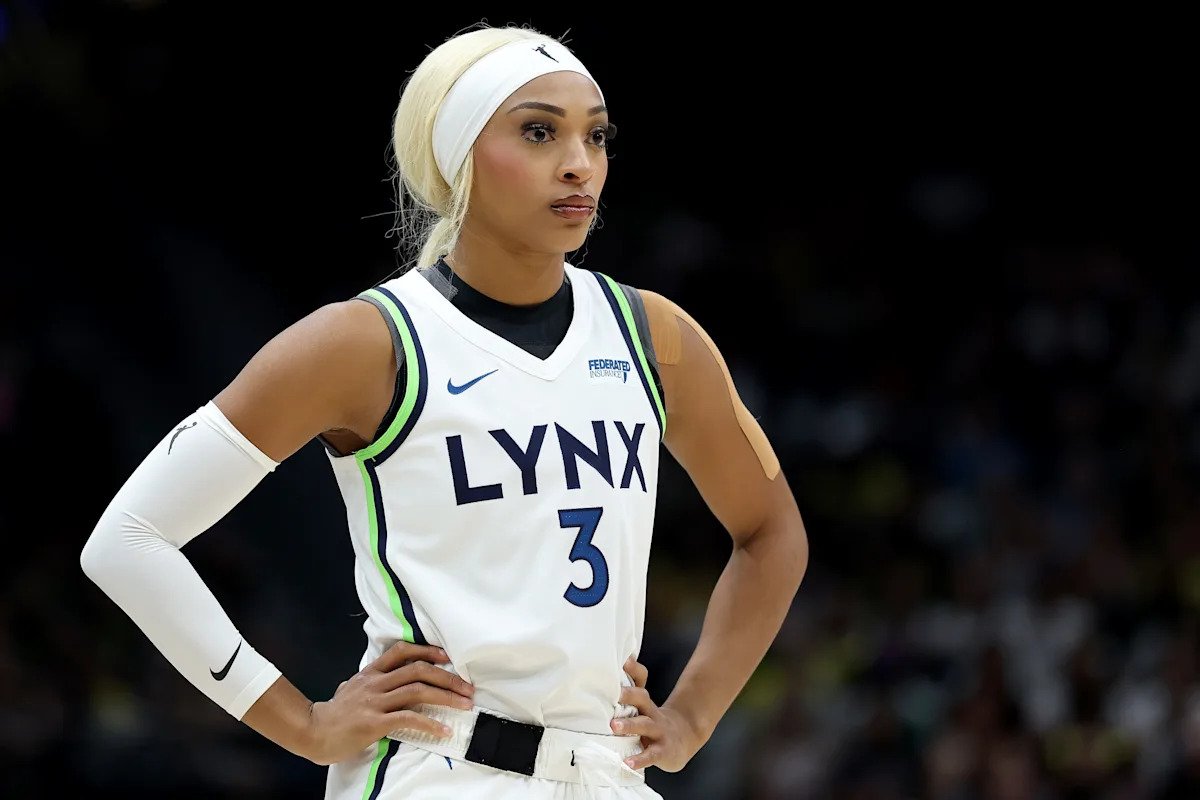
After offseason stagnation and three months of dominance, the Minnesota Lynx are finally facing change and challenges. An injury to their star and a new arrival will shake up their lineup. Will it risk their lead-leading record?
A Phee-less future
In the eternal battle between those who feel you should play until the final whistle and those who believe you should pull your starters when you have a big lead, the latter group claimed another “told you so” moment after the Lynx played the Las Vegas Aces on August 2. Late in the third quarter, while the Lynx were steamrolling the Aces, MVP-frontrunner Napheesa Collier went down with a right ankle sprain. She’s expected to be out at least two weeks.
Advertisement
While Minnesota’s playoff berth is already guaranteed (practically, if not literally), a Phee-less stretch could allow the New York Liberty to gain ground on the No. 1 seed. The two powerhouses play each other three times between August 10 and the 19, and Collier is guaranteed to miss at least the first two meetings, but will likely be absent in all three. However, even if the Lynx drop the series, they’ll still hold a two-game lead in the standings over the defending champions.
Two games isn’t a lot of cushion, but we’re mulling over first world problems right now. The Lynx and Liberty are simply campaigning for Finals homecourt advantage, and both teams are experienced enough to take their dominance on the road.
Collier’s absence will be felt more prominently by fans. Sans Collier, the triple-header Finals rematch has been reduced to “how much gas do Kayla McBride and Courtney Williams have in the first-option tank.” A fun experiment nonetheless, but incomparable to the navy and seafoam fireworks of the true budding rivalry.
Will DiJonai make a difference?

Just a couple of days before the trade deadline, the Lynx announced that they were trading Diamond Miller, Karlie Samuelson and their 2027 second-round pick to the Dallas Wings in exchange for Dijonai Carrington. Carrington, who won Most Improved Player last year while also landing on the All-Defense First Team, had struggled to find an impactful role in her first year on a miserable Wings team. Fans hail her as one of the best perimeter defenders in the league–a reputation that she deserves. However, if you ask anyone well versed in game film or analytics, they may have more nuanced views on her value.
Advertisement
The consensus on Carrington’s defensive ability will never be debated, nor should it. However, immediate reactions to the trade revealed that the casual fan seems to know, or care, very little about Carrington’s offense. The idea that she instantly makes the Lynx that much better seems to ignore the fact that Carrington, since entering the league, has consistently been one of the least serviceable offensive players in the WNBA.
In four of her five professional seasons, Carrington has shot worse than 31 percent from 3. Last year, that number sank to an abysmal 25 percent. This year it sits at 27.5. Of the 35 guards who have played 20 games and averaged 20 minutes this season, she’s the second-worst 3-point shooter. Her shooting woes would be dampened if they were reserved to the 3-point line, but they aren’t. Within five feet of the basket (so, layups), she shoots 48.9 percent; that’s second-worst amongst the 44 players who attempt at least three layups per game. Of all 67 of the true “rotational” players in the league (played 20 games and averaged 20 minutes), Carrington has the worst effective field goal percentage. Using the same parameters to rank rotational players, Carrington also turns the ball over at the sixth-highest rate.
In short, she doesn’t hit 3s, she doesn’t score well in the paint and she has a negative assist-to-turnover ratio.
Dijonai Carrington is a truly spectacular defender. I will never argue that. At the same time, fans shouldn’t ignore the fact that nearly every statistic points to her being the worst offensive rotational piece in the entire league. Dallas’ struggles absolutely contributed to her shortcomings, and I have few doubts that she will look much better as a member of the Lynx. However, can head coach Cheryl Reeve trust her to be on the court in a high-pressure playoff game? Will her shooting shortcomings be detrimental to the spacing that lets Collier operate in the post?
Advertisement
Minnesota seemed dead-set on moving on from Diamond Miller, so they didn’t lose much in the trade. Samuelson, who is out for the season with an injury, hadn’t had a meaningful impact either, and the organization doesn’t need to worry about second-round picks during a run of title contention. Carrington’s arrival surely hasn’t made them any worse, but it’s just a question of whether or not it’s made them better. At a glance, it’s a little too reminiscent of last year’s trade for Myisha Hines-Allen. She was better shooter than Carrington who still couldn’t be trusted offensively in big moments, and Minnesota didn’t choose to bring Hines-Allen back after their short rental.
It’s also hard not to think of the acquisition of Carrington in the context of the Minnesota-New York rivalry and their midseason arm’s race. Minnesota is taking a gamble on Carrington, while New York signed international superstar and former Finals MVP Emma Meesseman. Meesseman hasn’t played in the W since 2022, but teams—including the Lynx—have been hunting her every year in hopes that she would consider a stateside return. If the two teams meet once again with a championship on the line, which new addition will make the bigger difference? Given the unlikely nature of the teams facing each other at full strength next week, we may have to wait until the playoffs to find out.

